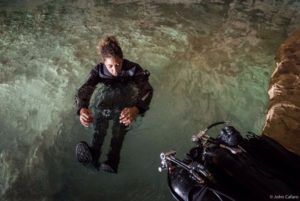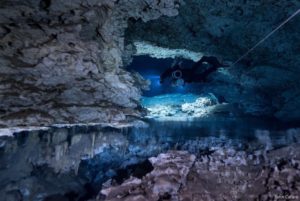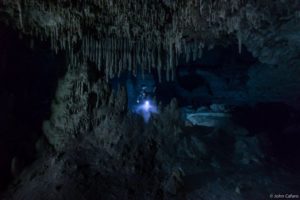As people live and work in the Yucatán Peninsula of Mexico, it may be unknown to some that we are standing on top of thousands of years history. Atop of what was once a vast coral platform, now a flooded underwater maze of rivers and passageways, so beautiful people come from all over the world to see, dive and document these spectacular Cenotes.
Without documentation of these cenotes, I don’t believe that many people including my family could fully understand what it is that I am living and diving amongst.
As an avid photographer myself I took to the caverns and caves with my camera. This environment proved much more difficult to capture the details and colours that I would be more likely to capture in the ocean on a casual dive.
Photography and videography in cave diving has more considerations than you would imagine. Now in a dark environment; in fact pitch black until illuminated by our video lights and strobes, I decided to leave the shutter button under the finger of my friends John Cafaro and Katy Fraser who are professionals.
In taking a pleasurable back seat to the photographer I soon found myself as model or lighting assistant.
As model this requires awareness of the line, gas, situational, environmental and light awareness in relation to the photographer and the angle at which he is shooting me from.
As lighting assistant this requires the same awareness but with a subject in the frame. It is my job to avoid being in shot, whilst illuminating either the diver and/or decorations in the foreground or background.
In cave diving photography – lighting, anticipation of the moving diver and co-ordination of the team make for a promising result.It is important to understand the vision of the photographer, hence the need for detailed briefings and debriefings for each dive.
Some considerations for shooting; Formations – Ceiling, floor or both. Spacious or narrow. Deep or shallow. Dark or white walls and what follows; how much light do we need and what is the burn time on those lights? As lighting on a cave dive is the limit to what you will see.
We now need to remember that this is technical diving, where in the cave do we want to shoot? what is our planned route and depth of penetration? how many team members are there? how much gas do we have and can we use?
Being a helping hand to the photographer/videographer allows for gas conservation of the photographer (As they can focus on getting the shot and not swimming around placing and picking up lights), more potential shots and more depth of field.
As interest in technical and cave diving grows, so does the peoples want for more travel and to discover something new. For our generation, snippets of our adventures are displayed through social media platforms and digital memories.
Our team have been a part of many productions; Phillip Gray ‘Extreme Artist’, Global Dive Guide, dive brand advertising among others.
At ProTec Diving Centre we offer this service of a Professional photographer or videographer to capture you in your cave diving glory at the highest professional standard.
Cave Guide and Technical Instructor at ProTec Tulum, Tamara May.




